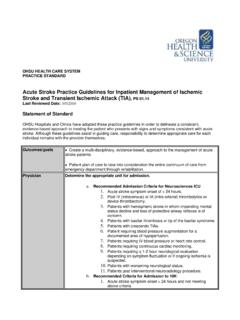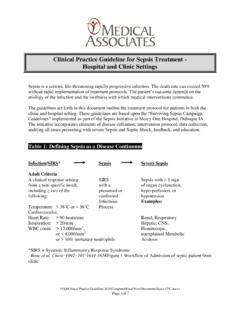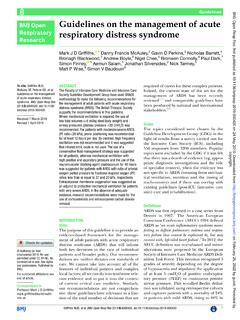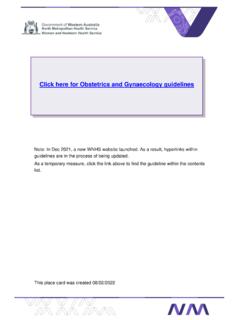Transcription of Adult Sepsis Empiric Antibiotic Guidelines
1 7 Adult Sepsis Empiric Antibiotic Guidelines Preface: These Guidelines outline Empiric Antibiotic recommendations from the Partners Sepsis Task Force and the Partners MDRO / Antibiotic Stewardship Collaborative for Adult patients with suspected Sepsis . Antibiotic choices should also take into account patient s histories, risk factors, and prior microbiology; severity of illness ( , broader antibiotics are generally warranted in critically ill patients , such as those with septic shock or respiratory failure); and each hospital s local antibiogram and pharmacy formularies. Bolded Antibiotic choices below indicate preferred regimens in most scenarios a Community-Acquired / Low Risk for Antibiotic Resistance - consider low-risk if none of the following are present: recent Antibiotic exposure, recent hospitalization, residence in a chronic care facility, hemodialysis, or immunocompromised.
2 B Healthcare Associated / High Risk for Antibiotic Resistance - consider at risk if: recent Antibiotic exposure, recent hospitalization, currently hospitalized > 5 days, residence in a chronic care facility, hemodialysis, or immunocompromised. *Use Imipenem or Meropenem if suspected or known prior colonization/infection with pathogens resistant to Cefepime, Ceftazidime, or Piperacillin/Tazobactam Presumed Source Community-Acquired / Low Risk for Antibiotic Resistancea Healthcare-Associated / High Risk for Antibiotic Resistanceb Unknown Vancomycin + Ceftriaxone Vancomycin + (Ceftazidime, Cefepime, or Piperacillin/Tazobactam) (if critically ill) Add Azithromycin or Levofloxacin if atypical pneumonia is possible Add Metronidazole if intraabdominal Sepsis is possible and no other anaerobic coverage Vancomycin + (Cefepime or Ceftazidime) Metronidazole Vancomycin + Piperacillin/Tazobactam Vancomycin + (Imipenem or Meropenem)
3 * Add Azithromycin or Levofloxacin if atypical pneumonia is possible Pulmonary Ceftriaxone + Azithromycin Levofloxacin is an alternative option, but should not be used as monotherapy if critically ill Add Vancomycin if critically ill, known MRSA colonization, or necrotizing pneumonia/empyema. Cefepime Piperacillin/Tazobactam Imipenem or Meropenem* Add Vancomycin if critically ill, known MRSA colonization, or necrotizing pneumonia/empyema Add Aminoglycoside or Levofloxacin if critically ill and/or very high-risk for MDR gram-negatives ( structural lung disease) Add Azithromycin or Levofloxacin if suspicion for Legionella Gastrointestinal/ Intraabdominal Ceftriaxone + Metronidazole Piperacillin/Tazobactam (if critically ill) Consider adding Vancomycin if critically ill Piperacillin/Tazobactam Cefepime + Metronidazole Imipenem or Meropenem* Consider adding Vancomycin if critically ill Skin/Soft Tissue Vancomycin + Ceftriaxone Add Metronidazole if infection involves the groin area.
4 If necrotizing infection suspected ( septic shock or crepitus), consult surgery and infectious diseases, and use Vancomycin + Piperacillin/Tazobactam + Clindamycin Vancomycin + (Cefepime or Ceftazidime) Add Metronidazole if infection involves the groin area, or use Piperacillin/Tazobactam instead of Cefepime/Ceftazidime. If necrotizing infection suspected ( septic shock or crepitus), consult surgery and infectious diseases, and use Vancomycin + (Piperacillin/Tazobactam or Imipenem or Meropenem) + Clindamycin Urinary Ceftriaxone Cefepime or Ceftazidime (if critically ill) Fluoroquinolones alone should NOT be used as first-line treatment Cefepime (or Ceftazidime) Imipenem or Meropenem* Add Vancomycin if severely ill, history of MRSA colonization in the urine, recent instrumentation, or indwelling foley 8 Beta-lactam Allergies: For most mild penicillin allergies ( minor rash without hives), a 3rd, 4th, or 5th generation cephalosporin or carbapenem can be safely used; for mild cephalosporin allergies, a carbapenem can be used.
5 If the patient has a severe beta-lactam allergy, alternative options for Gram-negative coverage in Sepsis include: Aztreonam, Ciprofloxacin or Levofloxacin, and Aminoglycosides. ID should be consulted in cases of severe allergies and limited Antibiotic choices. For additional information, refer to the Partners penicillin / cephalosporin hypersensitivity pathways ( ). Standard Antibiotic Dosing Regimens for Sepsis (consult pharmacy and/or local dosing Guidelines for help with vancomycin dosing and Antibiotic dosage adjustments in renal failure): Vancomycin load (20 mg/kg x 1, max 2 g) + maintenance (typically 15 mg/kg q8-12 hours) Ceftriaxone 2 g IV every 24 hours, Ceftazidime 2 g IV every 8 hours, Cefepime 2 g IV every 8 hours Piperacillin/Tazobactam g IV every 6 hours ( g every 6 hours can be used for non-pneumonia or non-severe cases where Pseudomonas is not suspected) Imipenem 500 mg IV every 6 hours, Meropenem 1 g IV every 8 hours Levofloxacin 750 mg IV every 24 hours Azithromycin 500 mg IV every 24 hours Metronidazole 500 mg IV every 8 hours Clindamycin 900 mg IV every 8 hours Subsequent Antibiotic Management.
6 patients with suspected Sepsis who are started on antibiotics will need to have them modified according to their clinical course and as diagnostic and microbiologic tests return. Generally, the 48-72 hour mark is an appropriate time for reassessment. Below are simple Guidelines for modifying antibiotics. *Procalcitonin may also be considered to help guide Antibiotic duration and early discontinuation in non-immunocompromised ICU patients with suspected or proven Sepsis (if available as rapid in-house testing at your hospital). Please refer to separate BWH Procalcitonin Guidelines on the Partners Handbook for more information and guidance. 10 Quick SOFA - the Sepsis -3 recommendations also propose that amongst patients with suspected infection, two or more quick SOFA criteria identify patients likely to have Sepsis and who are at high risk for adverse outcomes.
7 Because these criteria are measurable at the bedside and available prior to return of diagnostics, the Sepsis -3 recommendations suggest calculating qSOFA in all patients with suspected infection. Systolic Blood Pressure 100 mmHg Respiratory Rate 22 bpm Altered Mental Status (GCS <15) If patients have 2 qSOFA points, it is recommended that patients be urgently evaluated carefully for Sepsis , including a full set of laboratory tests to evaluate for organ dysfunction, and prompt consideration of source control. II. SEP-1 CMS Definition The definitions used by the Centers for Medicare and Medicaid for the SEP-1 measure have adapted the prior definitions of severe Sepsis and septic shock, which have been in place since the first consensus definitions of Sepsis were released in Severe Sepsis all 3 of the following, occurring within a 6 hour period: 1.
8 Suspected or documented infection 2. 2 Systemic inflammatory response syndrome (SIRS) criteria: Temperature > or < Heart rate >90 Respiratory rate >20 White blood cell count >12k, <4k, or >10% bands 3. Acute organ dysfunction attributable to infection (any one of the following): SBP <90 mmHg or MAP <65 mmHg or SBP drop from baseline by >40 mmHg Lactate > mmol/L Respiratory failure = need for noninvasive or invasive ventilation Creatinine > mg/dL or Urine output < cc/kg/hr x 2 hours Bilirubin > mg/dL Platelets <100k INR > or PTT >60 Septic Shock - Severe Sepsis and one of the following: 1. Persistent hypotension despite fluid resuscitation (30 cc/kg of crystalloid fluids), OR 2. Lactate mmol/L 11 III. Partners Guidelines on Defining Sepsis and Identifying patients At-Risk for Sepsis The Partners Sepsis Collaborative recognizes the difficulty in precisely defining Sepsis and septic shock.
9 Currently, the medical community is in a state of transition as the new Sepsis -3 definitions gain acceptance and familiarity. However, CMS has stated that they have no plans to update their criteria in the near future. Furthermore, others have raised concerns about the lack of prospective validation of the new criteria (including quick SOFA), and the possibility of harm that could result from shifting focus from early Sepsis /SIRS to qSOFA and organ ,16 While this is clearly a topic that will continue to evolve, our current approach is summarized below: 1. We agree with the Sepsis -3 approach to nomenclature, with Sepsis referring to organ dysfunction from infection (rather than severe Sepsis ). However, the utility of the SOFA score for guiding clinical care is unclear. The SOFA score, which was designed as a research tool, is not easy to memorize, c ontains variables that are not routinely measured in many non-ICU patients (such as PaO2/FiO2 ratio and Glasgow Coma Scale), and relies on clinical signs that are rapidly becoming outdated (such as the vasopressor/inotrope scoring system).
10 On the other hand, using well-defined single thresholds for organ dysfunction, such as some of the criteria used by CMS, is appealing. However, neither the CMS criteria nor SOFA help with the inherent subjectivity in deciding whether or not organ dysfunction is due to infection or another cause. Thus, we recommend classifying patients as having Sepsis if there is infection and either the CMS organ dysfunction thresholds are met OR there is a rise in SOFA score by 2. However, using severe Sepsis is still acceptable, given that this is the terminology used by CMS. Either way, clinicians should be as clear as possible when describing the clinical state of their patient ( , Sepsis with hypotension or acute kidney injury ). 2. We agree with that the systemic inflammatory response syndrome criteria should not be used to define Sepsis ; however, they can be still useful in identifying patients who are potentially infected.







